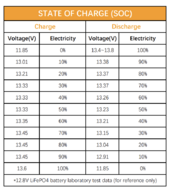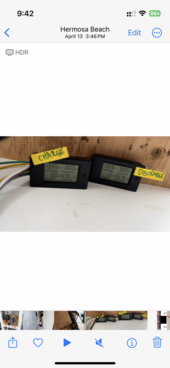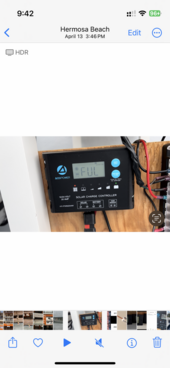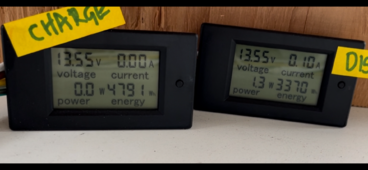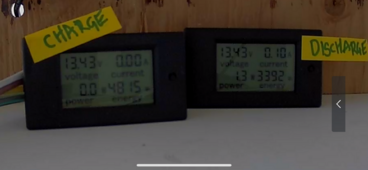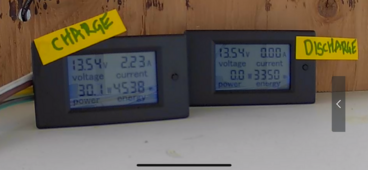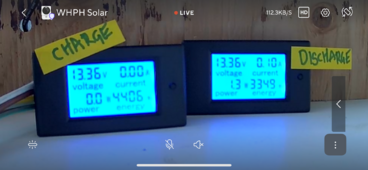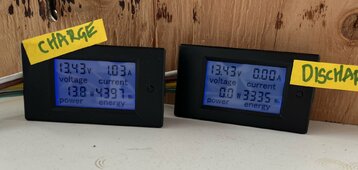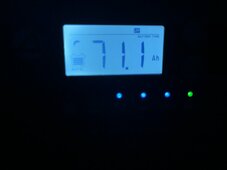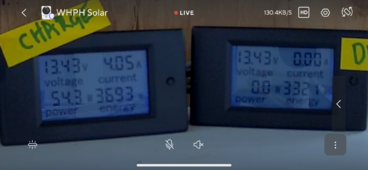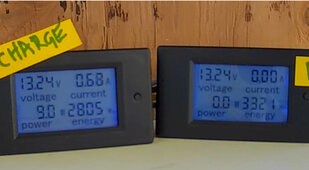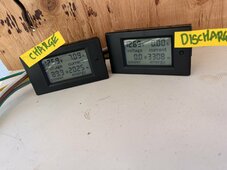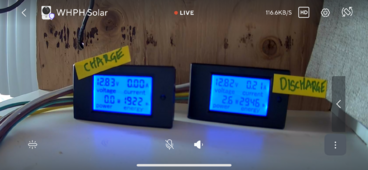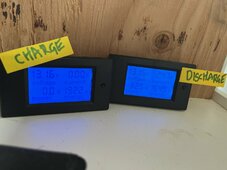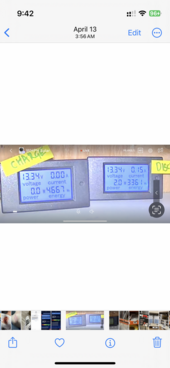WorldwideDave
New Member
Hello I am trying to diagnose a small DIY system. I think the panels are charging, just not certain. No expensive battery monitor. The SCC has a battery voltage on it, and I have a shunt with 2 meters connected to it - charge and discharge being monitored. The 'discharge' meter shows just fine - when I draw 12v loads (no inverter yet) from the LFP battery, it displays current, volts, watts just fine. The 'charge' meter used to change numbers when the solar was charging the system...but it has not for 2 weeks now. Here's my gear:
12v LiFePO4 battery (12v 200Ah CHINS).
Solar Panel 200 watts. (SP200 max power voltage 19.8V, max power current 10.1A, open circuit voltage 23.7V, short circuit current 10.6A)
20A solar charge controller (Acopower rated solar panel amps 10/15/20, normal solar input voltage 15-22, max solar voltage at no output load 25 volts).
Shunt meter (will recommended ones - have 2)
It seems strange that the meter would stop working. The wires are firmly installed. It looks to me like the solar panel never puts out more than 24 volts, and the max voltage by the solar controller is 25 watts, and the panel doesn't send out too many amps (10.1) and the solar charge controller seems to support 10/15/20, so seems within range?
I have really loaded the battery up to where it has lowered the voltage down to say 12.8 volts. But the voltage does seem to go back up to 13.2 or so daily.
I am thinking that I have a bad meter on the 'charge' side.
I suppose I could remove the meter from the charge and discharge sides, and swap to see if it is one of the two meters and not the wiring or SCC.
Is there a better way to test all this without buying a victron or expensive shunt? I do have a clamp amp meter. Solar panel connected with anderson connectors, so putting clamp amp meter around that may be a challenge as they are connected to one another. In other words clamp would go over postive and negative from the panel.
The panel does have a light on it to show voltage is hitting panel, so the fact that it lights up shows me the panel is working at least in some capacity.
Suppose it is possible that i fried the panel in direct sunlight on an extra hot day, but working voltage of the panel goes up to 150.
Related to this is that I think either the BMS or the solar charge controller stops the battery voltage from getting too high. Like the solar charge controller refuses to go over 13.4 volts.
I bought a 15 amp AC to DC battery charger for LFP batteries yesterday and connected it. It isn't super high quality, but when connected it said battery was 13.2 volts and within a short amount of time, it was trying to send it up to 14.4 volts. It is configured for LFP/LI batteries on the display. Why I think there is an issue maybe with the solar charge controller is because the battery should go up to 14.4 volts when charging I would think. See chart for battery below. I never have charged it close to the 40amps it recommends; usually my panel is at 5-6 amps. I am not discharging the battery anywhere near 200 AMPS.
So my guess is that the solar charge controller may have a problem charging this battery (gets to 13.4 and says float, even though in LiFePO4 mode), and the meter I have showing charging that stopped working is bad. Maybe. Open to suggestions/thoughts.

12v LiFePO4 battery (12v 200Ah CHINS).
Solar Panel 200 watts. (SP200 max power voltage 19.8V, max power current 10.1A, open circuit voltage 23.7V, short circuit current 10.6A)
20A solar charge controller (Acopower rated solar panel amps 10/15/20, normal solar input voltage 15-22, max solar voltage at no output load 25 volts).
Shunt meter (will recommended ones - have 2)
It seems strange that the meter would stop working. The wires are firmly installed. It looks to me like the solar panel never puts out more than 24 volts, and the max voltage by the solar controller is 25 watts, and the panel doesn't send out too many amps (10.1) and the solar charge controller seems to support 10/15/20, so seems within range?
I have really loaded the battery up to where it has lowered the voltage down to say 12.8 volts. But the voltage does seem to go back up to 13.2 or so daily.
I am thinking that I have a bad meter on the 'charge' side.
I suppose I could remove the meter from the charge and discharge sides, and swap to see if it is one of the two meters and not the wiring or SCC.
Is there a better way to test all this without buying a victron or expensive shunt? I do have a clamp amp meter. Solar panel connected with anderson connectors, so putting clamp amp meter around that may be a challenge as they are connected to one another. In other words clamp would go over postive and negative from the panel.
The panel does have a light on it to show voltage is hitting panel, so the fact that it lights up shows me the panel is working at least in some capacity.
Suppose it is possible that i fried the panel in direct sunlight on an extra hot day, but working voltage of the panel goes up to 150.
Related to this is that I think either the BMS or the solar charge controller stops the battery voltage from getting too high. Like the solar charge controller refuses to go over 13.4 volts.
I bought a 15 amp AC to DC battery charger for LFP batteries yesterday and connected it. It isn't super high quality, but when connected it said battery was 13.2 volts and within a short amount of time, it was trying to send it up to 14.4 volts. It is configured for LFP/LI batteries on the display. Why I think there is an issue maybe with the solar charge controller is because the battery should go up to 14.4 volts when charging I would think. See chart for battery below. I never have charged it close to the 40amps it recommends; usually my panel is at 5-6 amps. I am not discharging the battery anywhere near 200 AMPS.
So my guess is that the solar charge controller may have a problem charging this battery (gets to 13.4 and says float, even though in LiFePO4 mode), and the meter I have showing charging that stopped working is bad. Maybe. Open to suggestions/thoughts.




